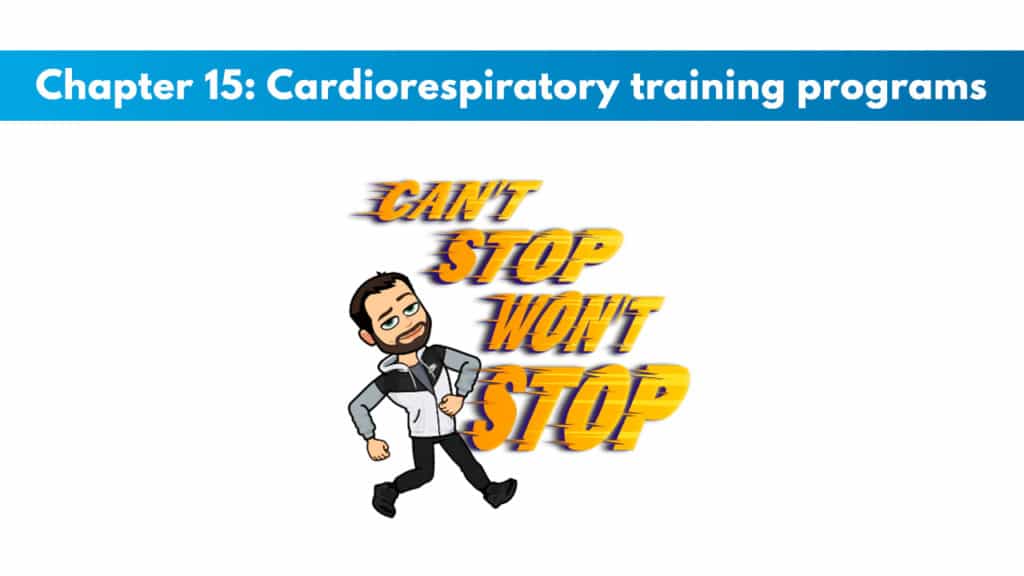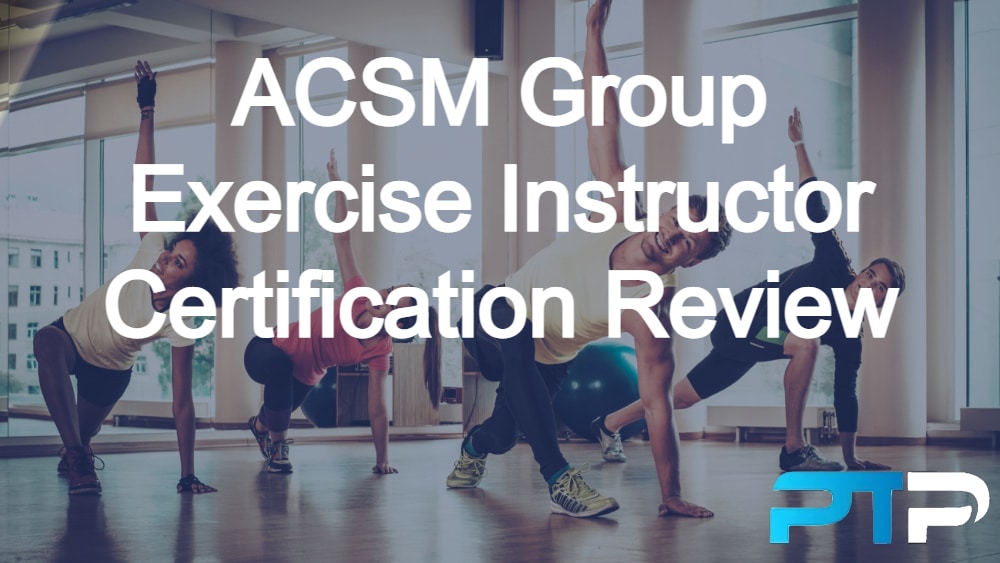
Get your copy of the ACSM CPT exam cheat sheet. It helps immensely for studying for the exam.
Make sure to check out Trainer Academy for premium ACSM CPT study materials. They will reduce study time by 50% and have an exam pass guarantee. Read my full review on them here. You can save $100 on their MVP study system with the code: PTPSUB
Chapter Objectives:
- Know the cardiovascular exercise guideline development over time.
- Use the FITT-VP principles of prescribing exercise for cardiovascular training.
- Know the physiological basis for the cool down and warm up.
- Be able to use the metabolic equations and MET values for finding workload.
General Training Principles
Cardiorespiratory endurance is the ability for someone to exercise that uses large muscles and is repetitive at a high to moderate intensity for a long time. The goal for this is to increase heart rate and respiration for the right physiological stress to occur. This is what we call overload.
Overload is the same as in the last chapter when used for resistance training, but now for cardio. Instead of increasing strength, we will increase our cardiorespiratory system’s effectiveness.
The benefits of having cardiorespiratory endurance are these:
- Decreases in the risk of dying prematurely from any and all causes, but mostly diabetes and heart disease.
- Reducing the death from cancer.
- More likelihood of better habits associated with health benefits.
The trainer must work to balance the frequency, intensity, duration, volume, and progression of the client’s workouts to avoid challenging the client too far over the overload level.
Exclusive PTP CPT Offers |
||
|---|---|---|
Gold Standard Cert | Most Popular Cert | Best Study Materials |
A Good Option | A Good Option | Best CPT for you?  |
Design of a Cardiorespiratory Training session
Warm-up
The warmup phase gradually prepares the body for the endurance phase, where we work hard. It takes us from rest to work. This is usually done with an activity like a brisk walk. For general purposes, this phase will be 5 – 10 minutes of a low intensity exercise of choice.
The benefits are:
- Potential reductions in injury susceptibility for muscles and joints due to the increase in connective tissue extensibility.
- Possible joint range of motion and function improvements.
- Potential muscle performance improvements.
- Possible prevention of ischemia in the heart, which occurs with sudden strenuous exertion.
Endurance Phase
This is the higher level of intensity and the phase that has us performing the overloaded need to train and produce the right cardiorespiratory adaptations.
Cool-Down
This is the opposite of a warmup. It brings the body from work to rest essentially. Typically, this will last about 10 minutes and gradually decrease in intensity.
Exercise Prescription for Cardiovascular Endurance
Frequency
The best frequency and recommended one by the ACSM is 3 – 5 days per week. The frequency, however, will vary on the chosen intensity. This has an inverse relationship. If the intensity is low, the frequency should be higher, and vice versa.
Intensity
The intensity needed should achieve overload. For people with lower fitness levels, the intensity could be as low as 45% of their oxygen uptake to produce this.
Methods of Estimating Intensity for Cardiorespiratory Endurance Exercise
We often use the VO2 max or the maximal heart rate formulas to estimate the intensities of this type of exercise. Some of these use the basis of age.
Exclusive PTP CPT Offers |
||
|---|---|---|
Gold Standard Cert | Most Popular Cert | Best Study Materials |
A Good Option | A Good Option | Best CPT for you?  |
Oxygen Uptake Reserve
When we use the VO2R, we find the target range for the client to stay in. The equation is as follows for a range of 40% to 89%:
- Target VO2 (lower end of the range) = ((0.4) X (VO2max – VO2rest)) + VO2 max
- Target VO2 ((upper end of the range) = ((0.89) X (VO2max – VO2rest)) + VO2 max
Some environmental conditions may make the relative intensity higher than the one prescribed.
Trainers need to monitor the response to their client’s exercises.
Heart Rate and Heart Rate Reserve
The formula for target heart rate is based on the percent of heart rate max for a range of 64 – 76% but up to 95% HRmax. The ACSM recommends this.
- Target HR (lower end of the range) = (max HR) X 0.64
- Target HR (upper end of the range) = (max HR) X 0.95
The Karvonen method is this:
- Target HR (lower end of range) = ((0.4) X (HRmax – HRrest)) + HRrest
- Target HR (upper end of range) = ((0.85) X (HRmax – HRrest)) + HRrest
Ratings of Perceived Exertion
These are subjective and are used to rate the client’s overall feeling while exercising. The common scale is 6 – 20 and the standard threshold for cardio benefits is within an RPE of 12 – 16.
The trainers and clients should usually use verbal descriptors to find their RPE. It is also the preferred method when working with older adults.
Talk test
The talk test is used for clients when they are doing cardio. This test looks for the point in the exercise where the client cannot speak normally due to the energy and force they put out. They might have moments of having to breathe without finishing a sentence. The goal should be to exercise close to this point.
Exercise Type or Mode
The mode is determined while considering the client’s fitness level, health, interests, and skill. Typically, these skills involve large muscle groups rhythmically and repetitively. They can be weight bearing or not.
The activity should interest the client for them to stick with it. Some activities include things like walking, running, swimming, biking, skating, and many others.
Time or Exercise Session Duration
ACSM recommends 30 – 60 minutes per day of moderate exercise, 20 – 60 minutes per day of vigorous, or some combination of these.
Sedentary people should start at the lower end, with even separate bouts of 10 minutes a few times in one day being an option to reach these times.
Volume or Amount (Calories Expended)
The exercise volume is the product of intensity, time, type, and frequency. This volume is used for estimating the overall caloric expenditure of the program. We usually express this value as kcal/day or a variant of that.
Progression
This is the same as the one we use for resistance training. This shows that the cardio system adapts without going past the overload level.
With progression, we gradually increase the intensity, frequency, and duration of the endurance phase, which results in more volume being done over time.

 Have a question?
Have a question? 



![ACSM Exam Prep [year] - How to Pass the ACSM Exam on the First Try 10 ACSM Exam Prep](https://www.ptpioneer.com/wp-content/uploads/2019/08/ACSM-Exam-Prep.jpg)
![FREE ACSM Study Plan, Study Calendar + Blueprint [year] 11 ACSM Study Plan](https://www.ptpioneer.com/wp-content/uploads/2022/12/ACSM-Study-Plan.jpg)
![FREE ACSM Study Guide [year] - Studying Made Simple 12 FREE ACSM Study Guide](https://www.ptpioneer.com/wp-content/uploads/2019/11/FREE-ACSM-Study-Guide-1.jpg)
![FREE ACSM Practice Tests [year] - 180+ Practice Questions 13 ACSM Practice Exams](https://www.ptpioneer.com/wp-content/uploads/2022/12/ACSM-Practice-Exams.jpg)
![FREE ACSM CPT Flashcards [year] - Over 950+ Flashcards! 14 ACSM Flashcards](https://www.ptpioneer.com/wp-content/uploads/2022/12/ACSM-Flashcards.jpg)


Tyler Read
PTPioneer Editorial Integrity
All content published on PTPioneer is checked and reviewed extensively by our staff of experienced personal trainers, nutrition coaches, and other Fitness Experts. This is to make sure that the content you are reading is fact-checked for accuracy, contains up-to-date information, and is relevant. We only add trustworthy citations that you can find at the bottom of each article. You can read more about our editorial integrity here.